Exchange Currency
Lebanese pound
The Lebanese pound is the currency unit of Lebanon. It is divided into 100 piastres but inflation has eliminated the subdivisions.
The plural form of lira, as used on the currency, is either lirat or the same, whilst there are four forms for qirsh: the dual qirshan (قرشان), the plural qirush (قروش) used with numbers 3-10, the accusative singular qirsha (قرشا) used with 11-99, or the genitive singular qirshi (قرش) used with multiples of 100. In both cases, the number determines which plural form is used. Note that before the Second World War, the Arabic spelling of the subdivision was غرش (girsh). All of Lebanon's coins and banknotes are bilingual in Arabic and French.
As the political status of Lebanon evolved, the Banque de Syrie, which was to act as the official bank for Lebanon and Syria, was renamed the Banque de Syrie et du Liban (BSL). The BSL was granted the sole right to issue a French franc based Lebanese-Syrian currency in Lebanon and Syria for 15 years starting in January 1924. In 1937, two years before the expiry of the 15-year period, the BSL was extended for another 25 years to issue in Lebanon a Lebanese currency separate from the Syrian currency, both of which could be used interchangeably in either state. Although the currency was Lebanese in name, it remained a disguised French franc until 1941, when it was linked to the pound sterling after the defeat of France and the invasion of Lebanon by the allied forces.
Following its independence in 1943, Lebanon concluded a monetary agreement with France in 1948 separating its national currency from the unstable French franc (Law of May 24th, 1949). Lebanon sought the lebanisation of the BSL. A council known as the Council of Money and Credit was formed to draw up the Money and Credit Code and the by-laws of Lebanon's future central bank, the Banque du Liban (BDL).The legal tender is the Lebanese pound. There are 14 denominations of banknotes issued by the BDL: the LBP 1, 5, 10, 25, 50 and 100 denominations were initially issued in 1964, LBP 250 in 1978, LBP 500 and 1,000 in 1988, LBP 10,000 in 1993, and 5,000, 20,000, 50,000 and 100,000 in 1994. Coins of LBP 100, 250, and 500 denominations were introduced in late 1995, and the LBP 50 came out in August 1997, followed by the LBP 25 in 2002.
After the war, the Arabic spelling was changed from girsh to qirsh. Coins were issued in the period 1952 to 1986 in denominations of 1, 2½, 5, 10, 25 and 50 qirsh and 1 lira. No coins were issued between 1986 and 1996, when the current series of coins was introduced.
After 1945, the Bank of Syria and Lebanon continued to issue paper money for Lebanon but the notes were denominated specifically in "Lebanese pounds" (ليرة لبنانية, livre libanaise) to distinguish them from Syrian notes. Notes for 1, 5, 10, 25, 50 and 100 pounds were issued. In 1964, the Bank of Lebanon took over banknote production. Their notes are denominated in pounds. A 250 pound note reappeared in 1978, followed by higher denominations in the 1980s and 1990s as inflation drastically reduced the currency's value.
The plural form of lira, as used on the currency, is either lirat or the same, whilst there are four forms for qirsh: the dual qirshan (قرشان), the plural qirush (قروش) used with numbers 3-10, the accusative singular qirsha (قرشا) used with 11-99, or the genitive singular qirshi (قرش) used with multiples of 100. In both cases, the number determines which plural form is used. Note that before the Second World War, the Arabic spelling of the subdivision was غرش (girsh). All of Lebanon's coins and banknotes are bilingual in Arabic and French.
Summary info
Summary information about Lebanese pound- ISO 4217 Code:
- LBP
- Currency sign:
- ل.ل
- Country:
- Lebanon
- Subunit:
- piastre
- Coins:
- 50 pounds, 100 pounds, 250 pounds, 500 pounds
- Banknotes:
- 1000 pounds, 5000 pounds, 10 000 pounds, 20 000 pounds, 50 000 pounds, 100 000 pounds
- Central bank:
- Banque du Liban
History
Before the First World War, Lebanon and Syria were part of the Ottoman Empire and the Turkish pound was the legal tender. Following the downfall of the Ottoman Empire in September 1918, the Turkish pound was replaced by a sterling-based Egyptian currency (issued by a private British institution) as legal tender in the states under the joint French and British mandate. Upon taking Lebanon and Syria under its separate mandate, the French Government sought to replace the Egyptian currency and granted a commercial bank - the Banque de Syrie, a French affiliate of the Ottoman Bank - the authority to issue a currency for states under its new mandate, namely the new Syrian currency.As the political status of Lebanon evolved, the Banque de Syrie, which was to act as the official bank for Lebanon and Syria, was renamed the Banque de Syrie et du Liban (BSL). The BSL was granted the sole right to issue a French franc based Lebanese-Syrian currency in Lebanon and Syria for 15 years starting in January 1924. In 1937, two years before the expiry of the 15-year period, the BSL was extended for another 25 years to issue in Lebanon a Lebanese currency separate from the Syrian currency, both of which could be used interchangeably in either state. Although the currency was Lebanese in name, it remained a disguised French franc until 1941, when it was linked to the pound sterling after the defeat of France and the invasion of Lebanon by the allied forces.
Following its independence in 1943, Lebanon concluded a monetary agreement with France in 1948 separating its national currency from the unstable French franc (Law of May 24th, 1949). Lebanon sought the lebanisation of the BSL. A council known as the Council of Money and Credit was formed to draw up the Money and Credit Code and the by-laws of Lebanon's future central bank, the Banque du Liban (BDL).The legal tender is the Lebanese pound. There are 14 denominations of banknotes issued by the BDL: the LBP 1, 5, 10, 25, 50 and 100 denominations were initially issued in 1964, LBP 250 in 1978, LBP 500 and 1,000 in 1988, LBP 10,000 in 1993, and 5,000, 20,000, 50,000 and 100,000 in 1994. Coins of LBP 100, 250, and 500 denominations were introduced in late 1995, and the LBP 50 came out in August 1997, followed by the LBP 25 in 2002.
Coins
Lebanon's first coins were issued in 1924 in denominations of 2 and 5 girush (note the different spelling to post WWII coins) with the French denominations given in "piastres syriennes" (Syrian piastres). Later issues did not include the word "syriennes" and were in denominations of ½, 1, 2, 2½, 5, 10, 25 and 50 girsha. During World War II, rather crude ½, 1 and 2½ girsh coins were issued.After the war, the Arabic spelling was changed from girsh to qirsh. Coins were issued in the period 1952 to 1986 in denominations of 1, 2½, 5, 10, 25 and 50 qirsh and 1 lira. No coins were issued between 1986 and 1996, when the current series of coins was introduced.
Banknotes
Lebanon's first banknotes were issued by the Bank of Syria and Greater Lebanon (Banque du Syrie et Grand-Liban) in 1925. Denominations ran from 25 girsha through to 100 pounds. In 1939, the bank's name was changed to the Bank of Syria and Lebanon. The first 250 pound notes appeared that year. Between 1942 and 1950, the government issued "small change" paper money in denominations of 5, 10, 25 and 50 girsh or qirsh (the change in spelling occurred during these years).After 1945, the Bank of Syria and Lebanon continued to issue paper money for Lebanon but the notes were denominated specifically in "Lebanese pounds" (ليرة لبنانية, livre libanaise) to distinguish them from Syrian notes. Notes for 1, 5, 10, 25, 50 and 100 pounds were issued. In 1964, the Bank of Lebanon took over banknote production. Their notes are denominated in pounds. A 250 pound note reappeared in 1978, followed by higher denominations in the 1980s and 1990s as inflation drastically reduced the currency's value.
LBP banknotes pictures gallery
| 1000 Lebanese pounds | |
|---|---|
| Banknote of 1000 Lebanese pounds has dimensions 115×61 mm and main colors are xanadu, dark sea green, platinum, cadet grey and turquoise green. Date of issue of 1000 Lebanese pounds banknote was November 11, 2011 | |
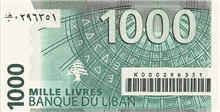 Obverse side of the 1000 Lebanese pounds is showing the alphabet and the cedar of Lebanon. |
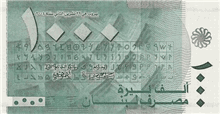 Reverse side of the 1000 Lebanese pounds is showing the alphabet and the cedar of Lebanon. |
| 5000 Lebanese pounds | |
|---|---|
| Banknote of 5000 Lebanese pounds has dimensions 140×70 mm and main colors are tea rose, pale chestnut, payne’s grey, tan and desert sand. | |
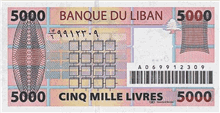 Obverse side of the 5000 Lebanese pounds is showing Geometric designs and the cedar of Lebanon. |
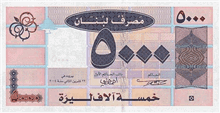 Reverse side of the 5000 Lebanese pounds is showing Geometric design and the cedar of Lebanon. |
| 10000 Lebanese pounds | |
|---|---|
| Banknote of 10000 Lebanese pounds has dimensions 145×73 mm and main colors are flax, flavescent, light khaki, dark tan, terra cotta and white smoke. | |
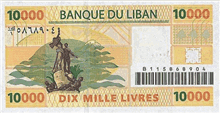 Obverse side of the 10000 Lebanese pounds is showing the geometric designs. |
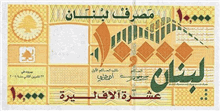 Reverse side of the 10000 Lebanese pounds is showing the monument. |
| 20000 Lebanese pounds | |
|---|---|
| Banknote of 20000 Lebanese pounds has dimensions 150×80 mm and main colors are beaver, desert sand, pastel brown, snow and dark chestnut. | |
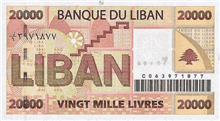 Obverse side of the 20000 Lebanese pounds is showing Modern geometric designs symbolizing the reconstruction of Lebanon. The front gate of the building of Banque du Liban, built in 1964, is illustrated with 16 squares on the face of the note and symbolizes the reconstruction taking place in Lebanon. There are 25 rectangles in the background of the note. These symbolise the unity of the 25 "Cazas" of the country. This unity constitutes the indispensable basis to the guarantee of the safety, the prosperity and the future of Lebanon. |
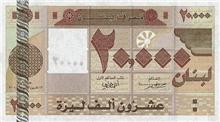 Reverse side of the 20000 Lebanese pounds is showing the geometric designs. |
| 50000 Lebanese pounds | |
|---|---|
| Banknote of 50000 Lebanese pounds has dimensions 140×77 mm and main colors are trolley grey, taupe gray, isabelline, lavender gray and dark electric blue. | |
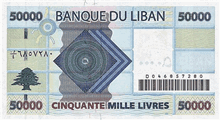 Obverse side of the 50000 Lebanese pounds is showing the cedar tree. |
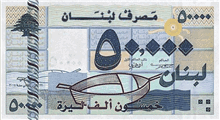 Reverse side of the 50000 Lebanese pounds is showing the artistic boats. |
| 100000 Lebanese pounds | |
|---|---|
| Banknote of 100000 Lebanese pounds has dimensions 147×82 mm and main colors are moonstone blue, dark sea green, pastel blue, white smoke and mint cream. | |
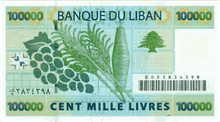 Obverse side of the 100000 Lebanese pounds is showing the cedar tree. |
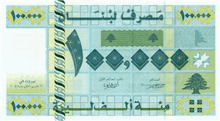 Reverse side of the 100000 Lebanese pounds is showing the grapes. |
Useful links
- About Banque du Liban:
- Banque du Liban
- List of currencies:
- Currencies
- Security and design features of LBP banknotes:
- LBP banknotes
- LBP currency on Wikipedia:
- Lebanese pound
- Official Website of Banque du Liban:
- www.bdl.gov.lb
- Commemorative coins:
- Commemorative Coins